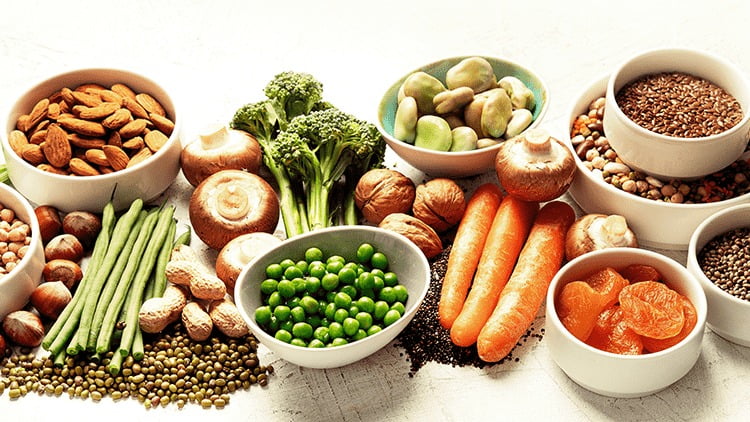Ever wondered why you feel lazy after a meal or struggle with occasional constipation? If you’re not making a conscious diet choice, you might not consume enough fiber. To feel better and eliminate these issues, you need to include more fiber in your diet.
Fiber, the indigestible part of plant-based foods, is crucial in keeping our digestive system happy and our bodies functioning optimally.
But what exactly is fiber, and how can we get more of it? We’ll discuss all of this in this article, so let’s get started!
What is Fiber?
Fiber is a type of carbohydrate found in plant-based foods that our bodies can’t digest completely. Unlike other carbohydrates that break down into sugars for energy, fiber passes through our digestive system mostly intact.
It adds bulk to stool, promoting regularity and preventing constipation. Fiber also helps regulate blood sugar levels by slowing down the absorption of sugar in the intestines. This can be especially beneficial for people with diabetes or those looking to manage their weight. Additionally, studies suggest that fiber can help lower cholesterol levels and reduce the risk of heart disease.
Read the article: Fuel Your Morning with These Fiber-Packed Breakfast Bowls
Top High-Fiber Foods to Include in Your Diet
Fiber diet is a way of eating that primarily focuses on including plenty of fiber-rich foods in your diet. These foods are naturally packed with fiber, providing your body with the necessary benefits. If you’re unaware of the top high-fiber foods to include in your diet, here’s a list to help you with it.
Lentils
In 1 cup of cooked lentils, you get 15.6 grams of fiber. It’s a great source of plant-based protein and fiber. They are also versatile and can be added to soups, stews, salads, and dips.
Chia seeds
Just two tablespoons of chia seeds provide over 10 grams of fiber. They’re incredibly versatile and can be added to smoothies, yogurt, oatmeal, or even baked goods.
Brussels sprouts
One cup of cooked Brussels sprouts offers about 4 grams of fiber. They’re also rich in vitamins C and K.
Broccoli
A cup of chopped broccoli contains about 2.5 grams of fiber. It’s a cruciferous vegetable, which means it may have some cancer-fighting properties.
Kidney beans
Like lentils, a cup of cooked kidney beans provides nearly 15 grams of fiber. They’re also a good source of potassium and folate.
Black beans
A cup of cooked black beans provides about 15 grams of fiber. They’re a delicious and affordable source of plant-based protein and antioxidants.
Pears
A medium pear with the skin on offers about 6 grams of fiber. They’re also a good source of vitamin C and potassium.
Avocados
Half an avocado provides about 10 grams of fiber. Avocados are also a great source of healthy fats, vitamins, and minerals.
Oatmeal
A half-cup serving of cooked oatmeal contains about 4 grams of fiber. It’s a heart-healthy breakfast choice that can keep you feeling full for hours.
Apples
A medium apple with the skin on offers about 4.5 grams of fiber. Apples are a convenient and portable snack that’s also low in calories.
Raspberries
A cup of raspberries provides about 8 grams of fiber. They’re also a good source of vitamin C and antioxidants.
Bananas
A medium banana provides about 3 grams of fiber. Bananas are a good source of potassium and a natural source of energy.
Sweet Potatoes
One medium sweet potato with the skin on offers about 4 grams of fiber. They’re also a good source of vitamin A and beta-carotene.
Flaxseeds
Just one tablespoon of ground flaxseeds provides about 3 grams of fiber. You can add them to smoothies, yogurt, or oatmeal for an extra fiber boost.
Whole wheat bread
Two slices of whole wheat bread provide about 3 grams of fiber. Choose whole wheat over white bread whenever possible to increase your fiber intake.
Barley
A cup of cooked barley provides about 8 grams of fiber. It’s a chewy whole grain that can be added to soups, stews, or salads.
Quinoa
A cup of cooked quinoa provides about 5 grams of fiber. It’s a complete protein, which means it contains all nine essential amino acids.
Artichokes
One medium artichoke provides about 5 grams of fiber. They’re a unique and delicious vegetable that can be steamed, roasted, or boiled.
Nuts and seeds
Most nuts and seeds are good sources of fiber. For example, a one-ounce serving of almonds provides about 4 grams of fiber.
Popcorn
Three cups of air-popped popcorn provide about 3.5 grams of fiber. It’s a healthy and satisfying whole-grain snack that’s low in calories.
Don’t Forget to Balance Your Fiber Intake
While increasing your fiber intake is good for your health, it’s important to do so gradually. A sudden jump can lead to bloating and gas. Start by adding small amounts of high-fiber foods into your diet and slowly increasing your intake.
- Increase gradually. To avoid bloating and gas, gradually increase your fiber intake over time to allow your digestive system to adjust.
- Stay hydrated. Fiber absorbs water, so drinking fluids is essential to prevent constipation.
- Spread it out. Aim to include fiber at every meal and snack throughout the day.
Remember, a balanced and varied diet is key. By following these tips, you can easily increase your fiber intake and get several health benefits it offers.
Join Cure and Craft:
Calling all healthcare professionals, medical students, and writers! Share your insights, experiences, and knowledge on our platform. Let’s craft informative articles together, shaping the future of healthcare. Connect, inspire, and enlighten our audience.






One thought on “Fiber Diet: Top High-Fiber Foods to Include in Your Diet ”